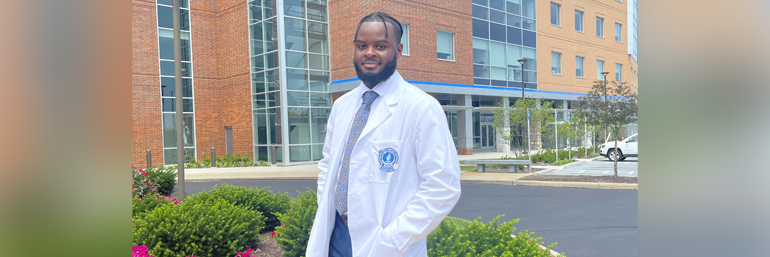Aug 17

Roy James II: Setting the Stage for Compassionate Care
There’s one patient skill that will never show up on a written test — one that Roy James II started learning when he was a theater student at the Cleveland School of the Arts.
“When you’re acting, you people-watch, you try to understand their perspective. One of the things I learned in theater was to never prejudge your character. You see the good guys and the bad guys in the movies. But we were taught to really think about what they want and what circumstances led up to them being the person that they are today.
“I think that can be similarly applied to medicine. There are no bad patients, right? Everybody has a story, and that causes you to say, let me find out what their story is before I pass any kind of judgment. Maybe if I find out what their story is, I can figure out a way to better communicate with them to meet their needs,” says James, a first-year College of Medicine student.
Visiting the hospital once a month seemed normal to James when he was growing up in Cleveland. His grandmother and great-grandmother both struggled with diabetes, and he and his family helped them manage the condition in whatever way they could. It wasn’t until later that James realized that this was not optimal care.
The experience shaped him.
“You always have a drive to protect people you love, but as a kid you don’t have the knowledge or skills to completely do that. I knew I wanted to fix it—that’s why I wanted to be a doctor,” James said in a recent conversation between classes.
A path to the profession
James reflected on how spending a year earning a master’s degree in Modern Anatomical Sciences (MAS) from the College of Graduate Studies prepared him to matriculate into the University’s M.D. program. The MAS program helps students like James fill in any academic gaps in their foundation for medical training. Those who earn a master’s degree in Modern Anatomical Sciences are accepted to seamlessly matriculate – as James did – into the class of first-year College of Medicine students.
Last February, during his year in the MAS program, James participated in a panel discussion called Accelerating Diversity in Health Care. The NEOMED panel was organized by Sonja Harris-Haywood, Ph.D., interim associate dean for curriculum – the person who first drew James to the University through her mentorship.
“I don’t look good on paper,” he told attendees of that panel. In today’s conversation he adds, “You see my GPA: It was nothing pretty.” But James filled in the gaps in his preparation and feels confident about the qualities he brings to the profession in addition to his academic foundation: “Compassion, hard work, growth and maturity.”
Leading by mentoring
James is a member of the NEOMED chapter of the Student National Medical Association, which addresses concerns of students who are underrepresented in medicine. He’s excited about his new role as a co-mentorship chair. Splitting up the territory of Cleveland State University, Kent State University, the University of Akron and Youngstown State University, James and three other NEOMED students will work with health sciences advisors to identify and mentor undergrads who are Underrepresented Minorities in Medicine.
He benefited from his own mentors on his way to the College of Medicine, says James. Now, he hopes to help other students realize their full potential as transformational health care leaders.


